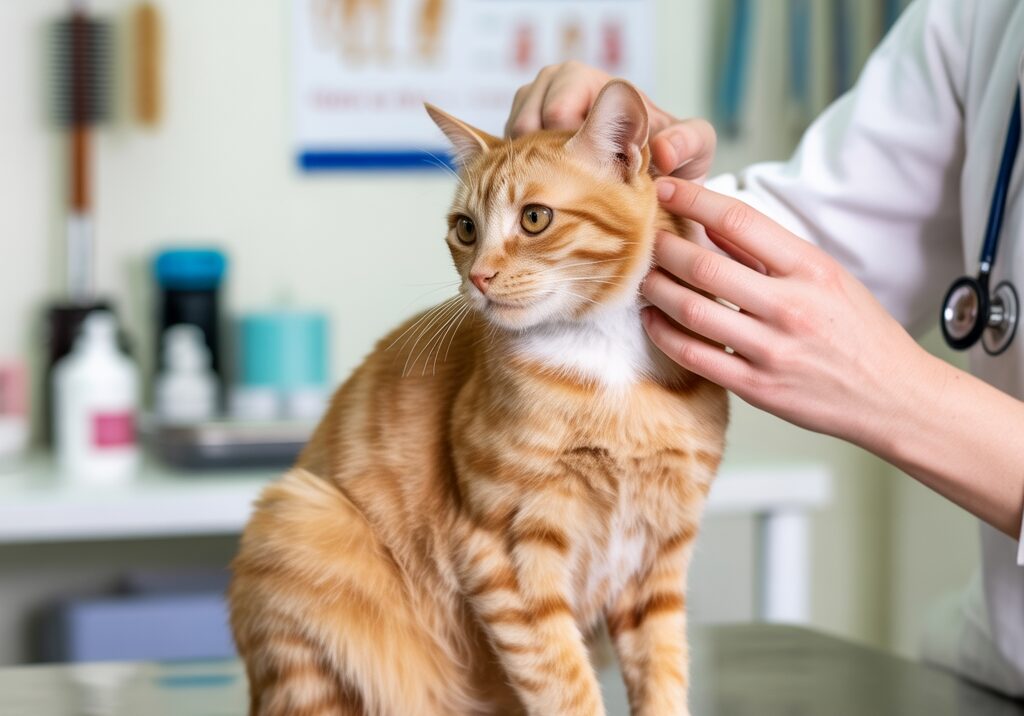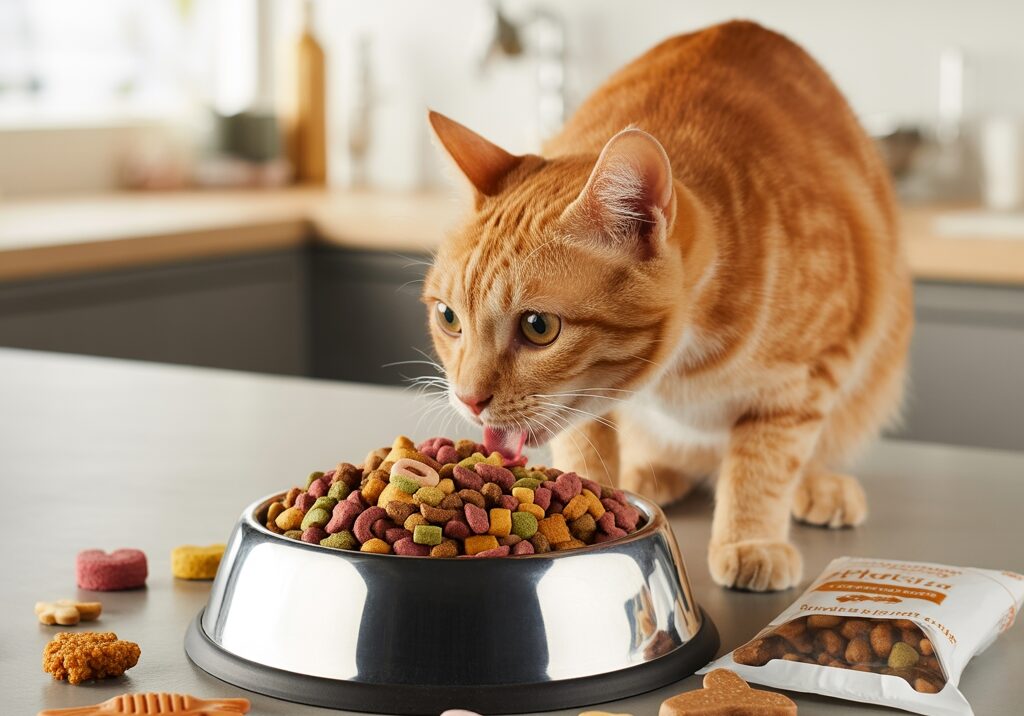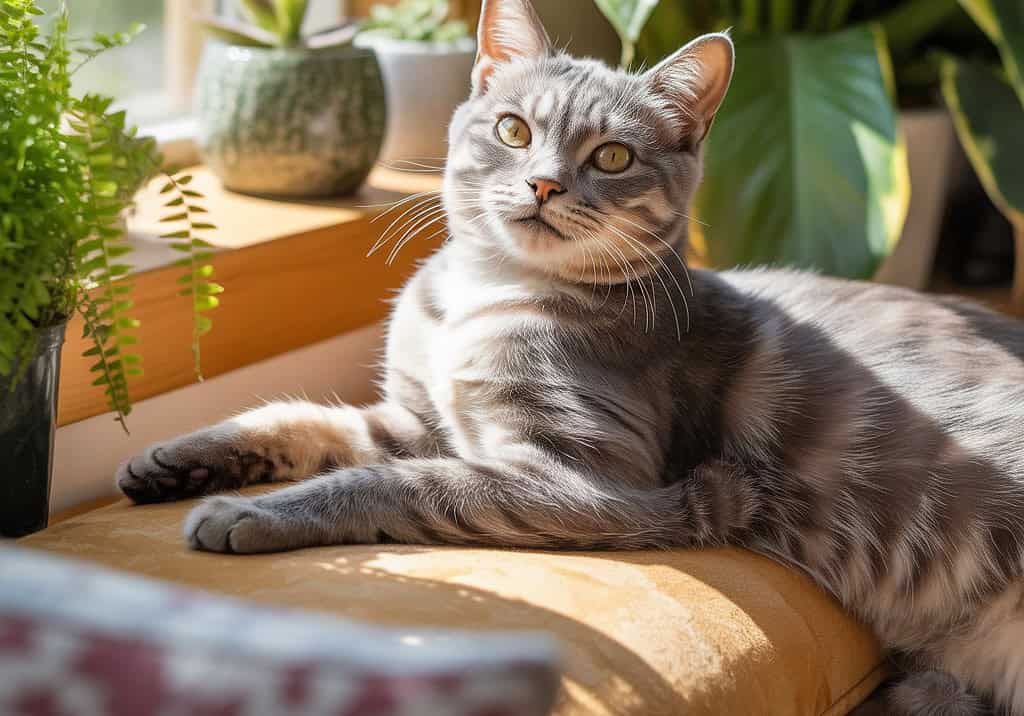As a cat owner, ensuring your feline friend leads a happy and healthy life is a top priority. Understanding cat behavior and creating a nurturing environment are crucial steps in achieving this goal.
By providing the right care and attention, you can significantly improve your cat’s overall well-being. This comprehensive guide will walk you through the essential steps to promote cat health and cat happiness, helping you become an expert in cat care.
Key Takeaways
- Understand your cat’s behavior and body language
- Create a safe and nurturing environment
- Provide a balanced diet for optimal cat health
- Stay on top of regular veterinary check-ups
- Show love and attention to boost cat happiness
Understanding Your Feline Friend
To ensure your cat leads a happy and healthy life, it’s crucial to understand their behavior and communication methods. Cats are complex animals with unique personalities, and recognizing their needs is key to a harmonious relationship.
Cat Behavior and Communication
Cats communicate primarily through body language and vocalizations. Understanding these signs can help you better care for your cat.
Reading Body Language
A cat’s body language can reveal their emotional state. For example, a relaxed cat will have a loose posture, while a tense cat may arch its back. Paying attention to these cues can help you tailor your interactions.
Vocalizations and Their Meanings
Cats use various vocalizations to communicate their needs or emotions. Meowing, purring, hissing, and growling are all forms of expression that owners should learn to interpret.
Different Cat Personalities
Just like humans, cats have distinct personalities. Some are playful and outgoing, while others are more reserved. Understanding your cat’s personality can help you provide the right environment and stimulation.
The Importance of Mental and Physical Health
A cat’s overall well-being depends on both mental and physical health. Ensuring your cat gets enough exercise, mental stimulation, and proper care is vital for their happiness and health.
Nutrition: The Foundation of Cat Health
The foundation of your cat’s health lies in the right nutrition, making dietary choices critical. A cat’s nutritional needs are complex and vary based on several factors including age, health status, and lifestyle.
Choosing the Right Diet
Selecting the appropriate diet for your cat involves understanding their nutritional requirements. Cats are obligate carnivores, requiring a diet rich in protein from animal sources.
Age-Appropriate Nutrition
Kittens, adults, and seniors have different nutritional needs. Kittens require more protein and calories for growth, while seniors may need fewer calories but more easily digestible nutrients.
Special Dietary Needs
Cats with health conditions may require special diets. For example, cats with kidney disease may need reduced protein diets, while those with food allergies may require hypoallergenic diets.
Wet vs. Dry Food
The debate between wet and dry food continues among cat owners. Wet food can provide higher moisture content, beneficial for urinary health, while dry food can help maintain dental health.
| Diet Type | Benefits | Drawbacks |
|---|---|---|
| Wet Food | Higher moisture content, can help with urinary health | More expensive, can be messy |
| Dry Food | Convenient, can help maintain dental health | Lower moisture content, can be high in carbohydrates |
Feeding Schedule and Portion Control
Establishing a regular feeding schedule and controlling portion sizes are crucial for maintaining your cat’s weight and overall health.
Common Dietary Issues
Cats can suffer from various dietary issues, including food allergies and obesity.
Food Allergies
Symptoms of food allergies in cats can include itching, scratching, and digestive issues. Identifying and eliminating the allergenic ingredient is key.
Obesity Prevention
Preventing obesity involves monitoring food intake and ensuring your cat gets enough physical activity. Regular weigh-ins and body condition scoring can help identify weight issues early.
“The key to managing your cat’s diet is understanding their individual needs and being mindful of the nutritional content of their food.”
Creating the Perfect Living Environment
Designing a cat-friendly home involves more than just providing the basics; it’s about creating a space that promotes happiness and health. A well-designed environment can significantly enhance your cat’s quality of life.
Setting Up Cat-Friendly Spaces
Cat-friendly spaces are essential for your cat’s mental and physical well-being. These areas should encourage exploration, play, and rest.
Vertical Space and Climbing Opportunities
Providing vertical space for your cat to climb and observe their surroundings can be very stimulating. Consider installing cat shelves or cat trees to create climbing opportunities.
Resting and Hiding Places
Cats need quiet, cozy spots to rest and hide. You can create these by setting up cardboard boxes or small enclosures in quiet areas of your home.
Litter Box Placement and Maintenance
Litter box maintenance is crucial for your cat’s health and happiness. Ensure the litter box is cleaned regularly and placed in a quiet, accessible location.
Safe and Stimulating Indoor Environments
Creating a safe and stimulating indoor environment involves cat-proofing your home and providing engaging activities.
Cat-Proofing Your Home
Cat-proofing involves securing loose wires, toxic substances, and fragile items out of your cat’s reach. This helps prevent accidents and ensures a safe environment.
| Cat-Proofing Tips | Benefits |
|---|---|
| Secure loose wires | Prevents electrical shock |
| Move toxic substances out of reach | Prevents poisoning |
| Use stable furniture and decorations | Prevents injuries from falling objects |
By implementing these strategies, you can create a living environment that is both safe and enjoyable for your cat, promoting their overall happiness and health.
The Ultimate Guide to Keeping Your Cat Happy and Healthy Through Play
Playtime is not just fun; it’s a vital component of cat care that contributes to their physical and mental well-being. Engaging your cat in various play activities helps maintain their overall health and strengthens your bond with them.
Types of Play and Toys
Cats have different preferences when it comes to play, and understanding these can help you choose the right toys. Two popular categories are hunting and chasing games, and puzzle toys for mental stimulation.
Hunting and Chasing Games
Toys that mimic prey, such as feather wands or laser pointers, encourage natural hunting behaviors. These games provide excellent exercise and can be very engaging for cats.
Puzzle Toys for Mental Stimulation
Puzzle toys challenge your cat to figure out how to get a treat out, providing mental stimulation. This type of play is crucial for preventing boredom and stress.
Exercise Needs by Age
Cats have different exercise needs at various stages of their lives. Kittens require more energetic play to support their growth and development, while older cats may need gentler activities to maintain flexibility and mobility.
Interactive vs. Solo Play
Both interactive and solo play are important for cats. Interactive play involves you directly with your cat, using toys or engaging in activities like hide-and-seek. Solo play, on the other hand, allows your cat to entertain themselves with toys like puzzle toys or catnip mice.
Creating Play Routines
Establishing a regular play routine helps ensure your cat stays active and engaged. Mixing different types of play and adjusting the routine according to your cat’s age and preferences can keep playtime interesting and fun.
Grooming Essentials
Cats require regular grooming to stay healthy and happy. Grooming is not just about keeping your cat looking good; it’s also crucial for their overall health and well-being.
Brushing Techniques for Different Coat Types
Different cats have different coat types, and each requires a specific brushing technique. For example, long-haired cats need regular brushing to prevent matting and tangling, while short-haired cats benefit from a weekly brush to remove loose hair and distribute skin oils.
- Long-haired cats: Use a pin brush or a slicker brush to gently detangle their coats.
- Short-haired cats: A rubber brush or a soft-bristle brush works well for their coats.
Bathing: When and How
Bathing is not a regular necessity for most cats, but when it’s needed, it’s essential to do it correctly. Use a gentle, pH-balanced shampoo, and ensure the water is not too hot or cold.
Nail Care and Dental Hygiene
Nail care and dental hygiene are critical aspects of grooming. Regular nail trimming prevents overgrowth, while dental care helps prevent tartar buildup and gum disease.
Tooth Brushing Methods
Tooth brushing is a vital part of dental care. Use a cat-specific toothbrush and toothpaste, and gently brush your cat’s teeth, focusing on the outer surfaces.
Dental Treats and Toys
Dental treats and toys can supplement brushing by helping to remove plaque and tartar. Choose products that are designed for dental health and are safe for your cat to consume.
Preventative Healthcare
A proactive approach to cat healthcare can significantly enhance your pet’s quality of life. By focusing on preventative measures, you can help ensure your cat remains healthy and happy.
Vaccination Schedules
Vaccinations play a critical role in protecting your cat from serious diseases. The vaccination schedule should be tailored to your cat’s lifestyle, age, and health status. Consult with your veterinarian to determine the most appropriate vaccination plan.
Parasite Prevention
Parasites such as fleas, ticks, and worms can cause significant discomfort and health issues for your cat. Effective parasite prevention strategies are crucial.
Fleas and Ticks
Fleas and ticks are not just pests; they can transmit diseases to your cat. Using flea and tick preventatives can help keep these parasites at bay.
Heartworm and Intestinal Parasites
Heartworms and intestinal parasites like roundworms and hookworms can cause serious health problems. Regular testing and preventative medication are essential for protecting your cat.
Regular Vet Check-ups
Regular veterinary check-ups are vital for maintaining your cat’s health. These visits allow for early detection of potential issues and ensure your cat stays up-to-date on preventative care.
Spaying and Neutering Benefits
Spaying or neutering your cat can have significant health benefits, including reducing the risk of certain cancers and preventing unwanted breeding. It’s a crucial aspect of responsible cat ownership.
Recognizing Health Issues Early
Early detection of health issues in cats can significantly improve treatment outcomes and quality of life. Cats are notorious for hiding signs of illness, making it crucial for owners to be aware of subtle changes in behavior or health.
Common Signs of Illness
Changes in appetite, water intake, or litter box behavior can be indicative of underlying health issues. Monitoring these aspects closely can help in early detection.
Changes in Eating or Drinking
A decrease or increase in appetite or water consumption can signal health problems. For instance, increased thirst could be a sign of diabetes or kidney disease.
Litter Box Problems
Issues such as accidents outside the litter box, changes in stool or urine output, or pain while urinating can indicate urinary tract infections or other health concerns.
Behavioral Changes to Watch For
Changes in vocalization, activity level, or affectionateness can also be signs of illness. For example, a normally active cat that becomes lethargic may be ill.
When to Seek Emergency Care
Certain symptoms require immediate veterinary attention. These include difficulty breathing, severe vomiting or diarrhea, and signs of pain or distress.
Urgent Symptoms
- Severe injury or trauma
- Ingestion of toxic substances
- Seizures or collapse
| Symptom | Possible Cause | Action |
|---|---|---|
| Increased thirst | Diabetes, kidney disease | Veterinary check-up |
| Litter box accidents | Urinary tract infection, kidney stones | Veterinary check-up |
| Severe vomiting | Gastrointestinal issues, poisoning | Emergency veterinary care |
Special Considerations for Kittens
The arrival of a new kitten marks the beginning of a journey that involves nurturing their growth and well-being. Kittens require special care, particularly in the early stages of their life, to ensure they develop into healthy, well-adjusted adult cats.
Socialization and Training
Socialization is a critical component of a kitten’s development. It involves exposing them to various environments, people, and other animals to help them become confident and calm in new situations. Proper socialization can significantly reduce the risk of behavioral problems later in life.
Handling and Touch Tolerance
Gentle handling from an early age helps kittens become tolerant of touch and handling, making future veterinary visits and grooming less stressful. It’s essential to handle kittens carefully, supporting their body and lifting them securely.
Basic Training Techniques
Introducing basic training techniques early on can help with housebreaking and establishing good behavior. Positive reinforcement, such as treats and praise, is an effective method for training kittens.
Growth Milestones
Monitoring a kitten’s growth and developmental milestones is crucial. This includes tracking their weight, ensuring they reach appropriate developmental stages, such as opening their eyes and starting to walk.
Kitten-Specific Health Concerns
Kittens are vulnerable to certain health issues, including parasites, infections, and congenital conditions. Regular veterinary check-ups are vital to identify and address these issues early. “The first few months of a kitten’s life are crucial for vaccinations and parasite control”, as noted by veterinary professionals.
Caring for Senior Cats
With age, cats’ requirements change, necessitating a compassionate and informed caregiving approach. As cats enter their senior years, typically around the age of 7-10 depending on breed and size, their health and comfort become increasingly important.
Adjusting Care for Aging Cats
Aging cats need adjustments in their diet, exercise, and overall care. Their nutritional needs may change, requiring a shift to senior-formula cat food that is easier to digest. Regular veterinary check-ups become more crucial to monitor their health and catch any issues early.
Managing Common Senior Health Issues
Senior cats are prone to various health issues, including arthritis and cognitive decline. Managing these conditions effectively is key to maintaining their quality of life.
Arthritis and Mobility
Arthritis is a common issue in older cats, causing pain and stiffness in their joints. Providing a warm, comfortable place to rest and minimizing jumps can help alleviate discomfort. In some cases, vets may recommend anti-inflammatory medication or joint supplements.
Cognitive Changes
Cognitive dysfunction in senior cats can manifest as confusion, disorientation, or changes in sleep patterns. Maintaining a consistent routine and providing mental stimulation can help manage these symptoms.
Making Your Home Senior-Friendly
Making simple adjustments to your home can significantly improve your senior cat’s life. This includes providing easy access to their favorite spots, using ramps or steps if necessary, and ensuring their litter box is easily accessible.
- Provide a comfortable, orthopedic bed.
- Minimize changes in the environment.
- Ensure easy access to food, water, and litter.
Travel and Temporary Care
Cats are creatures of habit, and traveling or changing their environment can be challenging, but there are strategies to make it easier for them. Whether you’re planning a short trip or an extended vacation, ensuring your cat’s comfort and safety is paramount.
Preparing Your Cat for Travel
Before traveling with your cat, it’s essential to prepare them for the journey. This includes acclimating them to their carrier and ensuring they have the necessary vaccinations and health checks.
Boarding vs. In-Home Pet Sitting
Deciding between boarding facilities and in-home pet sitting services depends on your cat’s needs and preferences. Boarding facilities can provide social interaction, while in-home pet sitting offers the comfort of a familiar environment.
| Service | Advantages | Disadvantages |
|---|---|---|
| Boarding Facilities | Social interaction, structured care | Exposure to other animals, potential stress |
| In-Home Pet Sitting | Familiar environment, personalized care | Cost, dependency on sitter’s availability |
Helping Cats Adjust to New Environments
To minimize stress when introducing your cat to a new environment, provide familiar items such as their bed or favorite toys. Gradual introduction to the new space can also help.
Reducing Stress During Changes
Maintaining a consistent routine and providing a safe space can significantly reduce your cat’s stress during travel or temporary care. Calming aids such as pheromone diffusers can also be beneficial.
“The key to a stress-free cat travel experience lies in preparation and understanding your cat’s individual needs.”
Conclusion: A Lifetime of Feline Happiness
Ensuring a lifetime of happiness for your cat involves a commitment to understanding their needs, providing a nurturing environment, and adapting care as they age. By following the guidelines outlined in this ultimate guide, you can create a fulfilling life for your feline companion, filled with joy, health, and love.
A comprehensive cat care summary highlights the importance of nutrition, play, grooming, and preventative healthcare in maintaining your cat’s overall well-being. By prioritizing these aspects, you can promote feline happiness and strengthen your bond with your cat.
As you continue to care for your cat, remember that every stage of their life brings new challenges and opportunities. By staying informed and adapting your care strategies, you can ensure a lifetime of happiness and health for your feline friend.









